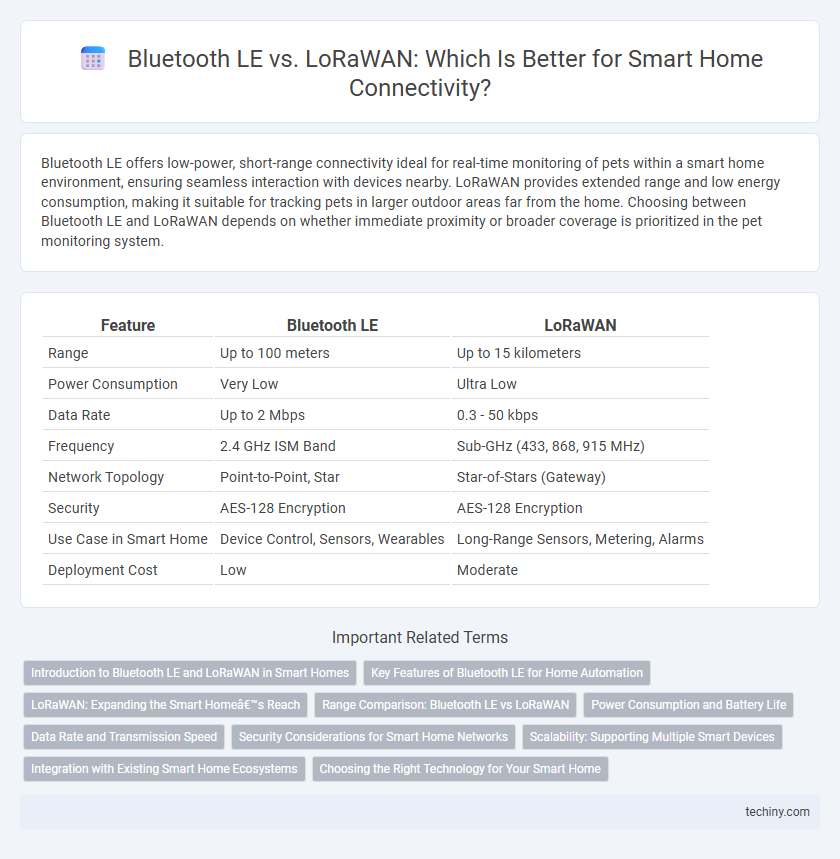Bluetooth LE offers low-power, short-range connectivity ideal for real-time monitoring of pets within a smart home environment, ensuring seamless interaction with devices nearby. LoRaWAN provides extended range and low energy consumption, making it suitable for tracking pets in larger outdoor areas far from the home. Choosing between Bluetooth LE and LoRaWAN depends on whether immediate proximity or broader coverage is prioritized in the pet monitoring system.
Table of Comparison
| Feature | Bluetooth LE | LoRaWAN |
|---|---|---|
| Range | Up to 100 meters | Up to 15 kilometers |
| Power Consumption | Very Low | Ultra Low |
| Data Rate | Up to 2 Mbps | 0.3 - 50 kbps |
| Frequency | 2.4 GHz ISM Band | Sub-GHz (433, 868, 915 MHz) |
| Network Topology | Point-to-Point, Star | Star-of-Stars (Gateway) |
| Security | AES-128 Encryption | AES-128 Encryption |
| Use Case in Smart Home | Device Control, Sensors, Wearables | Long-Range Sensors, Metering, Alarms |
| Deployment Cost | Low | Moderate |
Introduction to Bluetooth LE and LoRaWAN in Smart Homes
Bluetooth LE offers low-power, short-range wireless communication ideal for connecting smart home devices like sensors, locks, and lighting controls within a single residence. LoRaWAN supports long-range, low-data-rate connectivity suitable for large-scale smart home setups and smart city integrations, enabling devices to communicate over several kilometers. Both technologies enhance smart home automation by providing complementary options for device interoperability and energy efficiency.
Key Features of Bluetooth LE for Home Automation
Bluetooth LE offers low power consumption and high data transfer rates, making it ideal for home automation devices that require efficient communication with minimal battery drain. Its ability to support mesh networking enables extensive coverage and reliable device interconnectivity within a smart home environment. The protocol's widespread compatibility with smartphones and tablets facilitates easy control and integration of home automation systems.
LoRaWAN: Expanding the Smart Home’s Reach
LoRaWAN technology significantly extends the connectivity range of smart home devices beyond the typical 10-30 meters covered by Bluetooth LE, reaching up to several kilometers with minimal power consumption. Its low-power wide-area network (LPWAN) capabilities enable seamless communication across large properties and outdoor environments, effectively overcoming obstacles like walls and interference typical in urban settings. With its secure, long-range transmission, LoRaWAN enhances smart home automation by supporting devices such as sensors, alarms, and irrigation systems that require reliable, distant connectivity.
Range Comparison: Bluetooth LE vs LoRaWAN
Bluetooth LE offers a typical range of up to 100 meters in open environments, making it ideal for short-distance communication within smart home setups. LoRaWAN, by contrast, can transmit signals over several kilometers, often reaching up to 10 kilometers in rural areas, which is beneficial for wide-area smart home networks or smart city applications. The significant difference in range capabilities highlights LoRaWAN's suitability for extensive coverage, while Bluetooth LE excels in low-power, short-range device connectivity.
Power Consumption and Battery Life
Bluetooth LE technology offers ultra-low power consumption, making it ideal for smart home devices requiring frequent data exchange with minimal battery drain, often enabling multi-year battery life. LoRaWAN, designed for long-range communication, consumes more power per transmission but allows fewer transmissions and longer intervals, which can extend overall battery life in devices needing sporadic updates. Choosing between Bluetooth LE and LoRaWAN impacts smart home device power management strategies based on usage patterns and battery longevity requirements.
Data Rate and Transmission Speed
Bluetooth LE offers higher data rates up to 2 Mbps, enabling faster transmission speeds suitable for real-time smart home device communication. LoRaWAN, with data rates ranging from 0.3 kbps to 50 kbps, prioritizes long-range, low-power transmissions ideal for battery-operated sensors but results in slower data throughput. Choosing between Bluetooth LE and LoRaWAN depends on the specific smart home application needs for speed versus range and power efficiency.
Security Considerations for Smart Home Networks
Bluetooth LE employs strong encryption standards such as AES-128 to secure smart home devices, providing robust protection against eavesdropping and unauthorized access within close-range environments. LoRaWAN integrates end-to-end AES-128 encryption and mutual authentication mechanisms, enhancing secure long-range communication for smart home networks with minimal power consumption. Understanding the security capabilities of both protocols is essential for optimizing protection in smart home systems based on specific range and device interoperability requirements.
Scalability: Supporting Multiple Smart Devices
Bluetooth LE supports connectivity for dozens of smart home devices with low power consumption and efficient short-range communication, making it ideal for individual rooms or smaller spaces. LoRaWAN excels in scalability by enabling hundreds to thousands of devices to connect over wide areas, leveraging its long-range and low-power features to support extensive smart home networks and neighborhood integrations. The choice between Bluetooth LE and LoRaWAN for smart home scalability depends on the network size, device density, and coverage requirements.
Integration with Existing Smart Home Ecosystems
Bluetooth LE integrates seamlessly with popular smart home ecosystems such as Apple HomeKit, Google Nest, and Amazon Alexa, enabling direct device communication and easy control through smartphones or voice assistants. LoRaWAN, while excelling in long-range, low-power connectivity, typically requires a dedicated gateway and is less commonly supported by mainstream smart home platforms, limiting its integration capabilities. For homeowners prioritizing compatibility and straightforward setup within established ecosystems, Bluetooth LE offers superior integration and user experience.
Choosing the Right Technology for Your Smart Home
Bluetooth LE offers low power consumption and seamless integration with smartphones, making it ideal for short-range communication in smart home devices such as locks, lights, and sensors. LoRaWAN provides extended range and robust network coverage suitable for larger properties or outdoor applications requiring minimal power use and long-distance connectivity. Selecting the right technology depends on the specific smart home layout, required communication range, and device interoperability needs.
Bluetooth LE vs LoRaWAN Infographic

 techiny.com
techiny.com